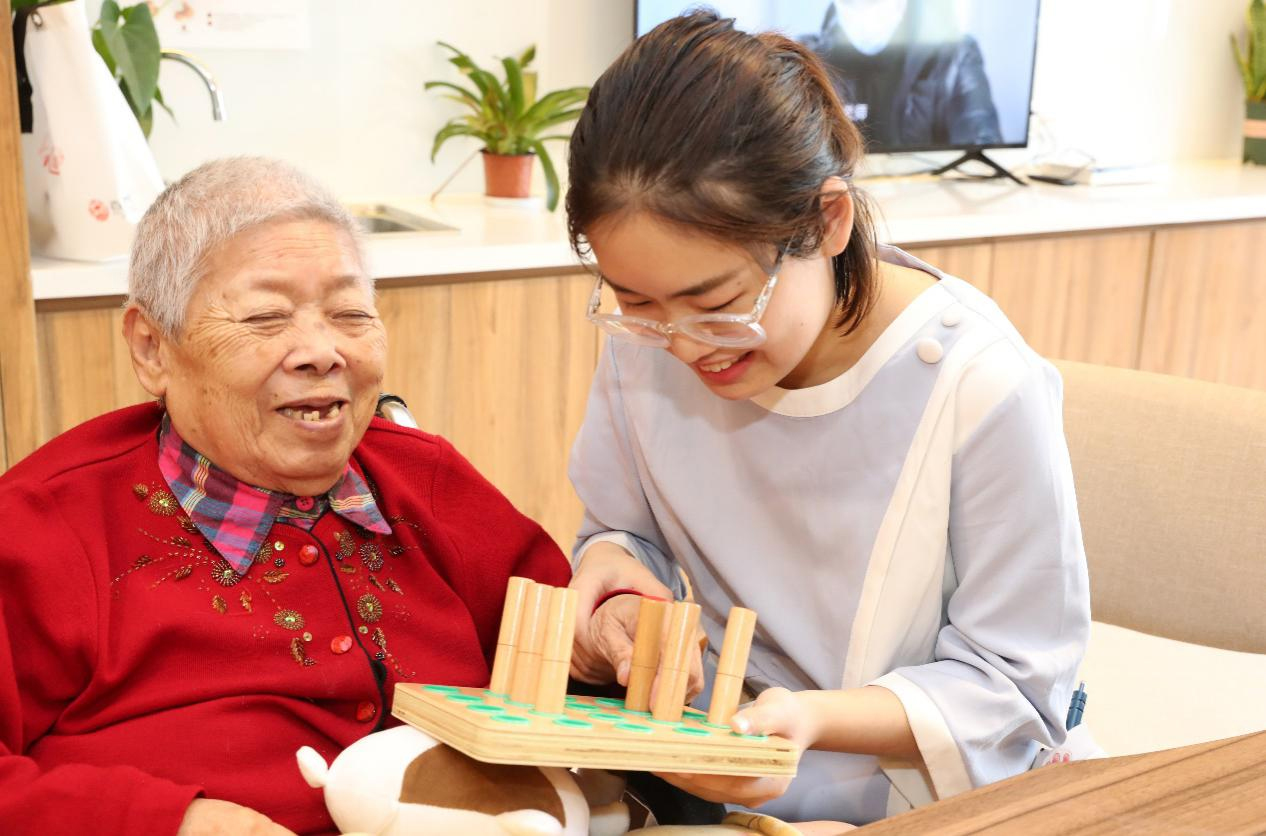

Since China entered an aging society at the end of the 20th century, the number of elderly people and their proportion in the total population of China have continued to grow.
From 2000 to 2019, the elderly population aged 60 and above increased from 126 million to 253.88 million, and the proportion of the elderly population in the total population increased from 10.2 percent to 18.1 percent.
China has the largest aging population in the world, and the problem of population aging will become more serious in the foreseeable future.

A worker at a nursing home helps a senior woman with finger disabilities receive rehabilitation training in Nantong, east China’s Jiangsu province. (Photo by Xu Congjun/People’s Daily Online)
Effectively responding to population aging will not only improve the quality of life and living standards of the elderly and safeguard their dignity and rights, but also promote economic development and social harmony.
Currently, more than 90 percent of the Chinese elderly choose to spend their later years at home and community-based elderly care centers.
How to ensure that these seniors can receive professional care services? Beijing has offered a solution with the model of its “fenceless” community-based nursing homes.
By introducing platforms such as professional elderly care institutions, housekeeping companies, shopping malls and supermarkets, and volunteer organizations, communities in Beijing provide elderly care services for seniors at their communities and homes, significantly improving their quality of life.
An 86-year-old woman surnamed Jiang is among the people who benefit from the elderly care model. Living in Yuetan neighborhood in the city’s Xicheng district, Jiang is hardly mobile and has difficulty feeding and bathing herself.

Home-based and community-based elderly care centers set up canteens to provide convenient services for senior residents at communities in Tongling, east China’s Anhui province. (Photo by Guo Shining/People’s Daily Online)
“Many thanks to the help of Ren Wuying, who I can rely on for any possible trouble,” Jiang said. Ren is a professional nursing worker of a nursing home at Jiang’s community.
Spending time together with Jiang when she was down in the dumps and taking care of her for a long time, Ren has forged a deep friendship with Jiang.
“She is always one call away even when she is having a meal,” Jiang said, adding that Ren is on intimate terms with her.
This is one of those “fenceless nursing homes” in Yuetan neighborhood. In 2019, nine nursing homes in Yuetan offered services such as day care, medical assistance, meal assistance, bath assistance, and recreational activities to over 160,000 person-times of seniors at 26 communities.
“It was a challenging task to meet residents’ demand for elderly care at some communities with a large aging population, few elderly care resources, and senior residents on relatively low income,” said Yu Rui, deputy director of Yuetan neighborhood citizen service center.
Now the problem can be easily solved by integrating home-based and community-based elderly care services and services of elderly care institutions, Yu noted.
In 2019, China had over 180 million elderly citizens suffering from chronic diseases, of whom 75 percent had more than one. Although the average life expectancy of Chinese people currently reached 77 years, people still suffer from a high prevalence of diseases and have to live with diseases.
Therefore, the integration of medical and elderly care is the answer to how to improve the living quality of senior citizens with diseases.
A 76-year-old woman surnamed Wu in Beijing understands the issue too well. “I suffer from prolonged illnesses, including cardiovascular diseases, and had a cerebral infarction,” she explained.
Six years ago, Wu moved to Dongli nursing home in the city’s Changping district. Beijing Longfu Hospital adjacent to the facility dispelled her worries about possible recurrence of her diseases, as the hospital cooperates with the nursing home. Therefore, it’s convenient for senior nursing home residents to see a doctor immediately and swipe their medical insurance cards to pay relevant fees.
Wu suddenly had a frog in her throat and was choked by water one month ago. After checking her medical history, doctors from the hospital immediately did magnetic resonance imaging or MRI scans for her and found that she had mild cerebral infarction.
Fortunately, her physical mobility was almost unimpaired thanks to early detection and treatment.

Workers at a day care center of a home-based elderly care nursing home carry out physical examinations for senior people in Dongxiang, east China’s Jiangxi province. (Photo by He Jianghua/People’s Daily Online)
“I didn’t want to sleep in the ward at night, so I came back to the nursing home,” Wu smiled, acclaiming the integration of medical and elderly care.
More and more seniors receive integrated elderly care and medical services at their own communities.
At Xiaocixuan elderly care center in Yuexiu district of Guangzhou, south China’s Guangdong province, Wen Xiaoni, a doctor from Baiyunjie community health service center, is seen carrying out a physical examination for a 94-year-old man Yu Shixiong.
“You have done a good job controlling your blood sugar levels,” Wen said and turned around to tell a nurse to reduce four units of insulin every day for Yu.
“The average age of seniors at our elderly care center reaches 87, and most of them suffer from chronic diseases,” said Li Min, deputy head of the Xiaocixuan elderly care center.
To enhance the integration of medical and elderly care, the nursing home has signed a service contract with the community health service center, and worked with nearby first-class hospitals at grade 3, the top level in China, including Guangdong Provincial People’s Hospital, so that seniors suddenly hit by a critical illness can be immediately transferred to these hospitals through a “green channel”, according to Li.
After several years of efforts, China has made positive progress in building an elderly care service system.
Zhao Chenxin, deputy secretary general of the National Development and Reform Commission (NDRC), said the country has continuously increased the investment in building the elderly care service system.
The NDRC has invested more than 12 billion yuan ($1.83 billion) from the central budget to support the building of the elderly care service system during the 13th Five-Year Plan period (2016-2020), Zhao added.
Going forward, China will continue to address inadequacies in elderly care services and enhance the quality of service from the perspectives of policy support, talent training and stronger regulations, so as to consolidate the policy system for the development of the elderly care industry.
In the long run, improving the multi-level elderly care system will boost the “silver economy.” He Xiaofeng, chairman of Dajia Insurance Group, believes that the building of a multi-level elderly care service system has great potential in meeting the demand for elderly care and creating jobs.
He added that vigorously developing elderly care services is not only an important measure to meet the basic living needs of people but also a significant means to support China’s domestic circulation.

 Award-winning photos show poverty reduction achievements in NE China's Jilin province
Award-winning photos show poverty reduction achievements in NE China's Jilin province People dance to greet advent of New Year in Ameiqituo Town, Guizhou
People dance to greet advent of New Year in Ameiqituo Town, Guizhou Fire brigade in Shanghai holds group wedding
Fire brigade in Shanghai holds group wedding Tourists enjoy ice sculptures in Datan Town, north China
Tourists enjoy ice sculptures in Datan Town, north China Sunset scenery of Dayan Pagoda in Xi'an
Sunset scenery of Dayan Pagoda in Xi'an Tourists have fun at scenic spot in Nanlong Town, NW China
Tourists have fun at scenic spot in Nanlong Town, NW China Harbin attracts tourists by making best use of ice in winter
Harbin attracts tourists by making best use of ice in winter In pics: FIS Alpine Ski Women's World Cup Slalom
In pics: FIS Alpine Ski Women's World Cup Slalom Black-necked cranes rest at reservoir in Lhunzhub County, Lhasa
Black-necked cranes rest at reservoir in Lhunzhub County, Lhasa China's FAST telescope will be available to foreign scientists in April
China's FAST telescope will be available to foreign scientists in April